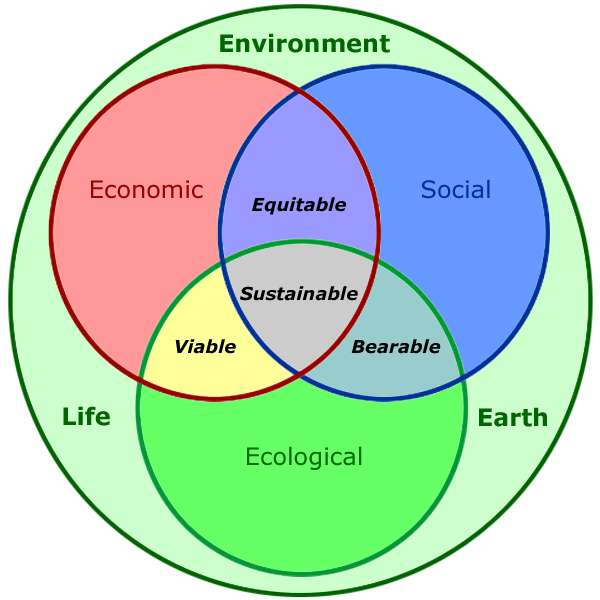Although conservationists often advocate sustainability, it's not always clear how this concept can be incorporated into our lives in a practical way. It requires people and institutions to use scientific knowledge to shape (or reshape) our ideals, practices, and laws. As a result, it stands at the junction of several fields of study--including (but not limited to) biology, sociology, economics, and philosophy. Previously, the development and implementation of sustainability plans may have been held back by our lack of scientific knowledge, but, according to collaborators writing in a recent issue of Frontiers in Ecology and the Environment, the greatest barrier to sustainable living is now our lack of direction.
To combat this problem, the authors have suggested five "priority themes" that should help both governments and individuals incorporate sustainable practices into everyday living. The themes were mainly developed with industrial societies in mind, as these are considered to be "the primary origin of the sustainability crisis," and also because these are the entities "better equipped...to actively address unsustainable behaviors."
The first of the themes is "reforming formal institutions," from local interest groups all the way up to the level of federal governments. Because institutions are "the underlying rules and structures that shape the social, economic, and political transactions within society," reform of these organizations can alter the way that decisions are made and rules are enforced. Integrating environmental policy considerations into basic institutional activities could help ensure that sustainable practices are discussed (and hopefully incorporated) in many sectors, ranging from finance and trade to energy, transport, and urban development.
However, the researchers recognize that institutional changes are driven by individuals, and also that individuals are active in society outside the framework of these organizations. Thus, their second theme is "engaging community in a stronger civil society." Institutions are often focused on "traditional imperatives" that are not easily married with sustainability--for instance, businesses want to make money, but green practices sometimes require large financial investments. Individual citizens, however, are not constrained by these same concerns; just as some communities design shared pastures and parks, so too might individuals come together to develop a "green" culture.
Achieving this will be easier if people remain mindful of the authors' third theme: "curbing consumption and population growth." The researchers suggest we should be particularly careful to minimize "inconspicuous consumption," or the use of objects and practices that are not actually necessary but have been employed for so long that we think of them as such--air conditioning, for instance, or long, hot showers. In order to "reorient economic life," the authors advocate research on the topic of whether, and how, people might be persuaded to "bring their preferences into better alignment with the requirements of ethics and sustainability." Simultaneously addressing population growth will not only have ecological benefits, the researchers argue, but also social ones--improved health, well-being, quality-of-life, and gender equality, to name a few.
Speaking of equality, the fourth theme is "equity and justice," two concepts that the authors admit are often thought to be far removed from the realms of science and conservation policy. However, these are important ideas because they determine who takes responsibility for certain activities or outcomes, and who has a say when decisions are made. For example, it is good to have clear guidelines in place for the disposal of hazardous waste, otherwise the same communities or areas might end up with an unfair amount of toxic garbage; likewise, predetermining who will be tasked with any emergency cleanups will ensure there are not legal hold-ups when and if any leakage does occur.
The final theme is "value and belief systems," which, of course, will influence all of the above. Factors such as age, gender, education level, and social status will cause individual variations in values over time, while societal variations will be driven by socioeconomic development. Because such fluctuations impact "human-environment relationships," the researchers stress the need to keep these factors in mind when developing conservation plans. They hope that we can find inspirations in worldviews that emphasize sustainability--not necessarily as a replacement for current beliefs, but as a "fresh perspective on sustainability problems," and a way to find "alternatives to consumption- and growth-based society." Understanding how these philosophies and emotions will impact each of the above themes, however, will likely require some inspired interdisciplinary research.
On the whole, the authors write, "sustainability requires a social avalanche of unprecedented proportions." Although the avalanche can be started by anyone, the researchers hope that conservation researchers might help initiate change by forging more transdisciplinary alliances--not just among academics but also between academia and other societal institutions. Further, they suggest that researchers should be more vocal in advocating sustainability; by finding novel and exciting ways to discuss this topic in public, scientists might inspire the public and begin to teach by example.
---
Fischer, J., Dyball, R., Fazey, I., Gross, C., Dovers, S., Ehrlich, P.R., Brulle, R.J., Christensen, C., and Borden, R.J. 2012. Human behavior and sustainability. Frontiers in Ecology and the Environment 10:153-160.
Thanks to the following websites for providing the images used in this post:
http://www.roscoedm.co.uk/sustainability.html
http://en.wikipedia.org/wiki/File:Human_Sustainability_Confluence_Diagram2.png
http://valmarassociates.com/index.php/services-solution-offerings/sustainable-business-practices/



No comments:
Post a Comment